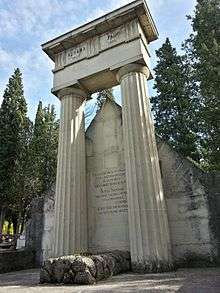Nicolás Salmerón y Alonso
Nicolás Salmerón Alonso (10 April 1838 – 21 September 1908) was a Spanish politician, president of the First Spanish Republic.
Nicolás Salmerón | |
|---|---|
.jpg) Portrait by Federico de Madrazo | |
| President of the Executive Power | |
| In office 18 July 1873 – 7 September 1873 | |
| Preceded by | Francisco Pi y Margall |
| Succeeded by | Emilio Castelar y Ripoll |
| Personal details | |
| Born | 10 April 1838 Alhama de Almería, Province of Almería, Spain |
| Died | 21 September 1908 (aged 70) Pau, France |
| Political party | Democratic Republican Union Party Progressive Party |
| Signature |  |
Biography
He was born at Alhama la Seca in the province of Almería, was educated at Granada and became assistant professor of literature and philosophy at Madrid. The last years of the reign of Isabella II were times of growing discontent with her government and with the monarchy. Salmerón joined a small party who advocated for the establishment of a republic. He was director of the opposition paper La Discusión, and co-operated with Emilio Castelar on La Democracia. In 1865 he was named one of the members of the directing committee of the Republican Party. In 1867 he was imprisoned with other suspects.
When the revolution of September 1868 broke out, he was at Almería recovering from a serious illness. Salmerón was elected to the Cortes in 1871, and though he did not belong to the Socialist Party, defended its right to toleration. When Amadeo of Savoy resigned the Spanish crown on 11 February 1873 Salmerón was naturally marked out to be a leader of the party which endeavoured to establish a republic in Spain. After serving as minister of justice in the Figueras cabinet, he was chosen president of the Cortes, and then, on 18 July 1873, president of the Executive Power of the Republic, in succession to Pi y Margall. He became president at a time when the Federalist Party had thrown all the south of Spain into anarchy.
Salmerón was compelled to use the troops to restore order. When, however, he found that the generals insisted on executing rebels taken in arms, he resigned (September 6) on the ground that he was opposed to capital punishment. He was again elected president of the Cortes on September 9. His successor, Castelar, was compelled to restore order by drastic means. Salmerón took part in the attack made on him in the Cortes on 3 January 1874, which provoked the generals into closing the chamber and establishing a provisional military government. Salmerón went into exile and remained abroad till 1881, when he was recalled by Sagasta.
In 1886, he was elected to the Cortes as Progressive deputy for Madrid, and unsuccessfully endeavoured to combine the jarring republican factions into a party of practical moderate views. On 18 April 1907 he was shot at, but not wounded, in the streets of Barcelona by a member of the more extreme Republican Party. He died at Pau on 21 September 1908.

References

| Political offices | ||
|---|---|---|
| Preceded by Francisco Pi |
President of the Executive Power of Spain 18 July 1873 – 7 September 1873 |
Succeeded by Emilio Castelar |
| President of the Provisional Government of Spain 18 July 1873 – 7 September 1873 | ||
| Wikimedia Commons has media related to Nicolás Salmerón. |